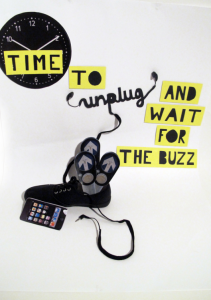Year 10 students undertake a statistical enquiry cycle which gets them discussing safe speeds.
Arts students design and produce posters with their own safety messages aimed at the iPod generation.
Secondary students explore the journeys they make as passengers and write persuasively about the need for safe decisions.
Students get hands-on when learning about forces in the context of safe road travel.
Visual arts: Designing posters with impact
Arts students design and produce posters with their own safety messages aimed at the iPod generation.
Interviewees: Wellington East Girls College teachers Hayley Carleton, unit author, and Ros Cameron, trialler.
Walking by foot is a safe and healthy way to travel. We developed a unit that improved students’ safe pedestrian behaviour using creative and playful advertising strategies. People, especially teenagers, don’t respond to lectures about what they shouldn’t do. We told our year 10 students that their challenge was to make road safety interesting and fun, so that other teenagers would want to engage with the issues.
We wanted to deepen understanding of how to approach crossing roads, minimising distractions such as mobile phones and iPods. At the same time we wanted students to learn about the design process and the relationship of text and images in creating an idea. We wanted them to produce artwork that would engage other teenagers because it was positive, light-hearted, humorous, and educational.
We started by asking what-if questions. What if there were no limitations about how you could cross the road? How might you get to school? We had amazing suggestions – from magnets to giant bubble machines.
To start students’ thinking about designing for a specific target market, and advertising with a positive message, we watched the Air New Zealand safety video Mile-high Madness with Richard Simmons:
We looked at how Richard Simmons used catch phrases linking aerobics with flight safety, for example, “Fit to fly” and “grab and pull”, and talked about how students could use humour in their own design work to capture people’s attention.
Students analysed how similar examples worked and whether the intention was being communicated effectively. In particular they looked at how the fun and serious elements were balanced.
The unit was such fun. All students were engaged and there was lots of energy, enthusiasm, and laughter. Students undertook research about the hazards they had noticed coming to school. This helped them frame what they wanted to help improve and what the focus for their artwork would be.
Each student chose something specific they wanted to improve, for example, encouraging the use of pedestrian crossings where available, or being alert to cars using the school driveway. Students produced road signage and posters using two-dimensional and three-dimensional collage.
Taking time to investigate thoroughly meant that what students came up with in terms of their artwork was solid. You get a key difference when students do the research rather than just being told something. It means they are doing the learning and embedding it in their own practice. Learning needs interaction with ideas.
Students knew why the message was important. We wanted students to be more alert and aware in their local road environment and we wanted them to make sensible decisions whether alone or in a group. We were impressed with students acknowledging that they had to use their brains independently when they were in a group, and their self-evaluations indicated some differences in behaviour, for example, a student wrote: “I now unplug my iPod and stop texting when crossing the road.”
As teachers, we are also much more aware of the issues and the importance of our own modelling: “I had to give myself 10 extra minutes to walk to school because I now only cross with green lights.”
Every student travels, so the topic was relevant for everyone. It’s about them and their lives. Each student had a unique personal idea and that’s something we always aim to achieve in our arts units.
We’d like to tell other teachers not to be put off by this unit being about road safety. It’s lively, fun and engaging for both students and staff.



